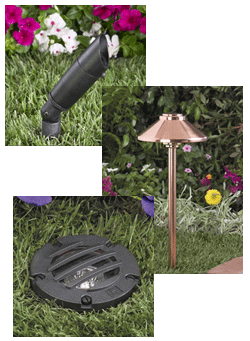Darkness is a much more energy conserving option than using lighting–that should go without saying. However, I would consider lighting to be a necessary element of Outdoor Living Spaces and flower beds.
Therefore, the solution is to find a more sustainable option than conventional lighting. The solution is to use low-voltage lighting, and especially the new LED lights that are available.
Quick lesson on physics: POWER=WORK X TIME. In other words, the amount you are billed for and consume each month depends on the wattage of the bulbs you use and how long you have the lights on each day.
I introduce this concept to you because it is important to understand that the term ‘low-voltage’ does not mean it conserves energy, it just means it uses the same amount of energy but does so with less energy flowing through the wires. The reason low-voltage lighting is a more sustainable option is because the fixtures tend to accomplish with lower wattage bulbs what it takes higher wattage bulbs to do in a regular 120 volt system.
to understand that the term ‘low-voltage’ does not mean it conserves energy, it just means it uses the same amount of energy but does so with less energy flowing through the wires. The reason low-voltage lighting is a more sustainable option is because the fixtures tend to accomplish with lower wattage bulbs what it takes higher wattage bulbs to do in a regular 120 volt system.
The new LED lights operate at about 3, 6 or 9 watts and compare in brightness with the 5, 10, and 20 watt lights of a typical low voltage lamp and 50, 75 or 100 watt bulbs for a 120 volt system. In fact, the low wattage LEDs in many situations surpass the brightness of the other bulbs. In other words, LEDs are a very sustainable option.
The other aspect of the equation affecting your energy consumption and therefore your bill is the length of time you have the system on at nights. There are many inexpensive options to regualate the amount of time your lights are on at night. I prefer to use a transformer with a timer and then a photocell interrupt.
Yeah, I know it sounds somewhat technical, but basically the concept is that you set the timer to have your lights come on at a certain time each day and shut off at a certain time each day, and then the photocell interrupt prevents the lights from turning on in the evening until it recognizes it is actually dark outside. The photocell feature saves you minutes and hours in the summer time evenings by keeping your lights off when they are not needed.
So if you are like me and believe that outdoor lighting is a necessary element for your landscape, use LEDs, a timer and a photocell interrupt to be as sustainable as possible and keep your electricity bill low!